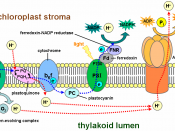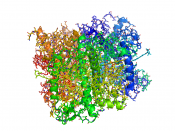Background:"Fee-fi-fo-fum" said the hungry giant. Remember that popular English story about a young boy whose family is so poor that he had to sell his cow for food but eventually sold it for magical beans? Those magical beans were real and over night, grew all the way up to the sky! How is this possible, people asked. Well it's mainly about the whole meaning of this lab, photosynthesis. Photosynthesis, in a nutshell, is process by which green plants and certain other organisms use the energy of light to convert carbon dioxide and water into the simple sugar glucose. In so doing, photosynthesis provides the basic energy source for virtually all organisms. You may be wondering now that why on earth the young boy from the story will instead climb the beanstalk instead of eating it? Well, an extremely important byproduct of photosynthesis is oxygen, on which most organisms including the young boy must depend on for food and life.
How does all of this happen in the plant, you ask? Well first things firsts, in every plant there are leafs, in every leaf there are cells, and in every plant cells there is a special organelle called a chloroplast. The chloroplast is the main organelle in which all of photosynthesis takes place (similar to the power house cell, the mitochondria, in an animal cell). Not all wavelengths of light are absorbed during photosynthesis. Green, the color of most plants, is actually the color that is reflected. The light that is absorbed splits water into hydrogen and oxygen:H2O + light energy ---> ý O2 + 2H+ + 2 electrons1. Excited electrons from Photosystem I can use an electron transport chain to reduce oxidized P700. This sets up a proton gradient, which can generate ATP. The end result of this looping electron...


